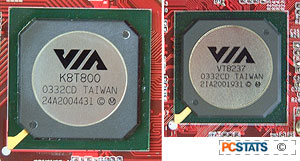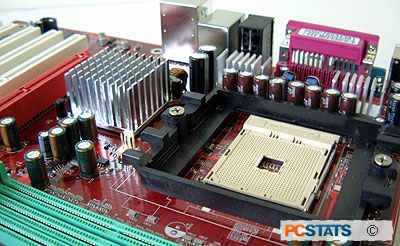VIA's platform for the Athlon64 is the K8T800. It's
offered in two varieties, the server/workstation version for the Opteron
processor and the Performance PC platform for the Athlon64. Both versions use
the VT8237 Southbridge.  The
major selling point for VIA's chipset is that it features a faster
Hypertransport link (800Mhz DDR for an effective 1.6Ghz) between the CPU and the
chipset than the offerings from the other companies.
The
major selling point for VIA's chipset is that it features a faster
Hypertransport link (800Mhz DDR for an effective 1.6Ghz) between the CPU and the
chipset than the offerings from the other companies.
As the K8T800 uses a 16-bit (meaning 16bits of
data in each Hypertransport packet) link, this enables the path to reach a
maximum bandwidth of 3.2GB/s (1.6Ghz * 16 / 8) in each direction for a rather
impressive maximum theoretical bandwidth of 6.4GB/s.
VIA proposition that problems with signal
interference have forced many of their competitors to resort to using lower
speed implementations of Hypertransport, a problem which they have resolved with
something called "Hyper8" technology.
Of course, this additional bandwidth is only useful
if it is actually being used by the system. Let's take a look at some numbers,
at least in general. Take the bandwidth needed for the memory transfer away,
since the controller is on the CPU itself and has its own private bus, and you
are left with the AGP bus and the other I/O subsystems like Serial ATA and PCI
feeding into the Hypertransport link.
AGP 8x has a theoretical maximum of 2.1GBps, which
is a hefty chunk of the available room, but what else is there? The headroom
needed for the accumulated contributions of all the other I/O subsystems is
pretty insignificant in comparison.
 If you take the
current implementations of USB2.0, Serial ATA and Gigabit Ethernet, not to
mention PCI, and combine them together the maximum bandwidth needed is still
well under 500MB a second.
If you take the
current implementations of USB2.0, Serial ATA and Gigabit Ethernet, not to
mention PCI, and combine them together the maximum bandwidth needed is still
well under 500MB a second.
VIA seem to acknowledge this, as the link between
the VT8235CE Southbridge chip and the k8T800 Northbridge is still only spec'd at
533MBps, the same as in VIA's current KT600 and Kt400A chipsets for the Athlon
XP processor line.
Maximum memory for the chipset is set at
4GB, though most companies producing K8T800 boards, including the K8T
Neo-FIS2R, have a 2GB limit.
7.1-channel audio, courtesy of Via's 'Vinyl'
integrated sound controller is also in the mix, along with the mandatory 10/100
Ethernet.
Despite the fact that the memory controller is now built into the Athlon64 processor,
the K8T800's passive heatsink did get quite warm during testing.
